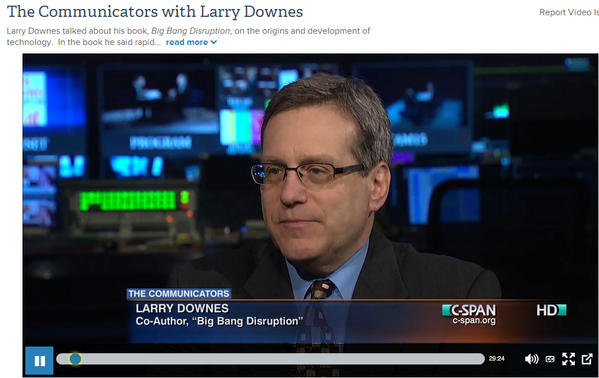 When the smoke cleared and I found myself half caught-up on sleep, the information and sensory overload that was CES 2013 had ended.
When the smoke cleared and I found myself half caught-up on sleep, the information and sensory overload that was CES 2013 had ended.
There was a kind of split-personality to how I approached the event this year. Monday through Wednesday was spent in conference tracks, most of all the excellent Innovation Policy Summit put together by the Consumer Electronics Association. (Kudos again to Gary Shapiro, Michael Petricone and their team of logistics judo masters.)
The Summit has become an important annual event bringing together legislators, regulators, industry and advocates to help solidify the technology policy agenda for the coming year and, in this case, a new Congress.
I spent Thursday and Friday on the show floor, looking in particular for technologies that satisfy what I coined the The Law of Disruption: social, political, and economic systems change incrementally, but technology changes exponentially.
What I found, as I wrote in a long post-mortem for Forbes, is that such technologies are well-represented at CES, but are mostly found at the edges of the show–literally.
In small booths away from the mega-displays of the TV, automotive, smartphone, and computer vendors, in hospitality suites in nearby hotels, or even in sponsored and spontaneous hackathons going on around town, I found ample evidence of a new breed of innovation and innovators, whose efforts may yield nothing today or even in a year, but which could become sudden, overnight market disrupters.
Increasingly, it’s one or the other, which is saying something all by itself. For one thing, how do incumbents compete with such all or nothing innovations?
That, however, is a subject for another day.
For now, consider again the policy implications of such dramatic transformations. As those of us sitting in room N254 debated the finer points of software patents, IP transition, copyright reform, and the misapplication of antitrust law to fast-changing technology industries (increasingly, that means ALL industries), just a few feet away the real world was changing under our feet.
The policy conference was notably tranquil this year, without such previous hot-button topics as net neutrality, SOPA, or the lack of progress on spectrum reform to generate antagonism among the participants. But as I wrote at the conclusion of last year’s Summit, at CES, the only law that really matters is Moore’s Law. Technology gets faster, smaller, and cheaper, not just predictably but exponentially.
As a result, the contrast between what the regulators talk about and what the innovators do gets more dramatic every year, accentuating the figurative if not the literal distance between the policy Summit and the show floor. I felt as if I had moved between two worlds, one that follows a dainty 19th century wind-up clock and the other that marks time using the Pebble watch, a fully-connected new timepiece funded entirely by Kickstarter.
The lesson for policymakers is sobering, and largely ignored. Humility, caution, and a Hippocratic-like oath of first-do-no-harm are, ironically, the most useful things regulators can do if, as they repeat at shorter intervals, their true goal is to spur innovation, create jobs, and rescue American entrepreneurialism.
The new wisdom is simple, deceptively so. Don’t intervene unless and until it’s clear that there is demonstrable harm to consumers (not competitors), that there’s a remedy for the harm that doesn’t make things, if only unintentionally, worse, and that the next batch of innovations won’t solve the problem more quickly and cheaply.
Or, as they say to new interns in the Emergency Room, “Don’t just do something. Stand there.”
That’s a hard lesson to learn for those of us who think we’re actually surgical policy geniuses, only to find increasingly we’re working with blood-letting and leeches. And no anesthesia.
In some ways, it’s the opposite of an approach that Adam Thierer calls the Technology Precautionary Principle. Instead of panicking when new technologies raise new (but likely transient) issues, first try to let Moore’s Law sort it out, until and if it becomes crystal clear that it can’t. Instead of a hasty response, opt for a delayed response. Call it the Watchful Waiting Principle.
Not as much fun as fuming, ranting, and regulating at the first sign of chaos, of course, but far more helpful.
That, if anything, is the thread of my dispatches from Vegas, in any case:
- “Telcos Race Toward an all-IP Future,” CNET
- “At CES, Companies Large and Small Bash Broken Patent System, Forbes
- “FCC, Stakeholders Align on Communications Policy—For Now,” CNET
- “The Five Most Disruptive Technologies at CES 2013, Forbes



